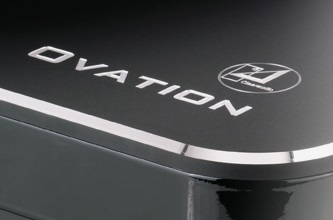Clearaudio is a well-respected manufacturer of turntables, tonearms, phono cartridges, phono preamplifiers, and accessories. Their home base is in Germany. The Clearaudio Ovation turntable has been in production for several years. The Ovation turntable features a rectangular footprint, belt drive, electronic speed control and Clearaudio’s patented CMB – Ceramic Magnetic Bearing. The CMB obliterates the need for a conventional platter bearing because the 8-pound platter floats on a magnetic cushion. This removes concerns about bearing wear, bearing chatter, or other related issues.
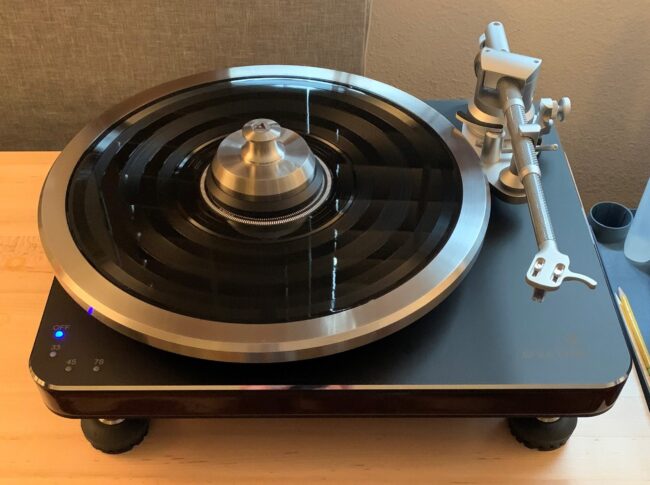
The plinth is unique. From the Web site:
“The Ovation’s main chassis consists of a complex sandwich of materials including heavy, machined aluminum plates compressing a core of bulletproof wood (Panzerholz). Within the precision-machined Panzerholz layer, Clearaudio has introduced an elaborate resonance-damping implementation with internal mass-loading tiles comprised of miniscule stainless-steel pellets. The high mass plinth uses three Innovation series locking/leveling aluminum cone feet to provide a stable foundation and acoustic isolation.” The plinth is very inert and provides an excellent platform for the platter “bearing”, which is little more than a ceramic post, and tonearm.
This review had a rough start. A standard “black/natural” Ovation arrived and had some speed issues. After extensive troubleshooting, the very kind distributor replaced that unit with a new unit that worked perfectly from day one. The cuing lever on the $6200 Clearaudio Universal tonearm would not stay in the raised position, and that, too, was replaced. In the quest to hear this model at its best, a black and then a silver Clearaudio Universal tonearm was installed. It was determined that the silver arm sounded better.
The stock armboard, drilled for the Clearaudio tonearm, also supports the standard Rega/Origin Live configuration, so it was a simple matter to install my Origin Live Agile tonearm on the $9500 Ovation. Are we having fun yet? YES! Phono preamplifiers included a Pass XP-25, Simaudio Moon 810LP, Sutherland TZ Direct, BMC MCCI ULN, Aurorasound VIDA MK.2 and VIDA Supreme. Phono cartridges included my reference ZYX UNIverse Optimum, Miyajima Destiny, and Tzar DST, all moving coil cartridges. An Origin Live mat was in use.
The Ovation superseded a VPI Aries 3D with a Phoenix Engineering Roadrunner/Eagle electronic speed control. After installing the Phoenix speed controller on the VPI and hearing the improvement, I consider electronic speed control essential for turntables. 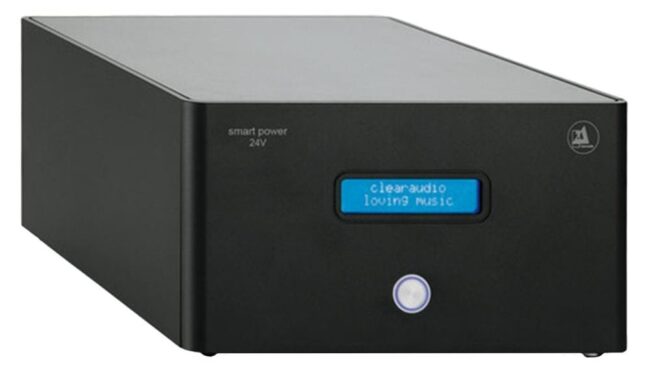
The Ovation was auditioned with Clearaudio’s Outer Limit record weight ($1500), which rests on the outer rim of the LP, a Clearaudio Innovation center weight/clamp ($750), and Clearaudio Smart Power Supply ($3500). The Outer Limit weighs 3 pounds 9 ounces and the Innovation clamp weighs 1 pound 11 ounces. Installing either or both clamps causes the platter to sit lower on the floating magnetic bearing, so VTA needs to be adjusted for the preferred configuration of clamps.
This is a good time to suggest that each and every part of the turntable “system” of table, tonearm, cartridge, cables, and phono preamplifier can affect the final sound significantly. Changing just the record clamp can noticeably change the final sound, as can a one-tenth of a gram change in vertical tracking force (VTF), tonearm-cartridge matching, cartridge loading changes of even a few Ohms, or a myriad of other possible changes. As such, this review refers to the complete turntable system as noted above.
After all the new parts had sufficient break in, a large sound stage image was noticed. This requires, among other things, that the platter speed is “dead-nuts” constant. This is because imaging is wholly dependent on the stability of phase, which is directly related to how consistent the speed of the platter is. Turntables with high wow and flutter are probably poor at presenting a stable sound stage image.
The sound is very well developed tonally, which helps with localizing performers and also with accurate and long-lasting harmonic tone. There is nothing tenuous or reticent about the presentation, but it is never forward or aggressive, either. This indicates the presence of a non-resonant platter.
The bass quality and quantity are excellent. The lower bass has the tightness and resolution to present vibrating strings on an acoustic bass with remarkable clarity. The bass is never dry or threadbare but is nicely rich and resonant. The VPI table, with its 20-pound metal platter, presents the lower frequencies with a bit more raw power, but the Ovation’s bass has just a bit more resolution and depth. The bass is clean and potent.
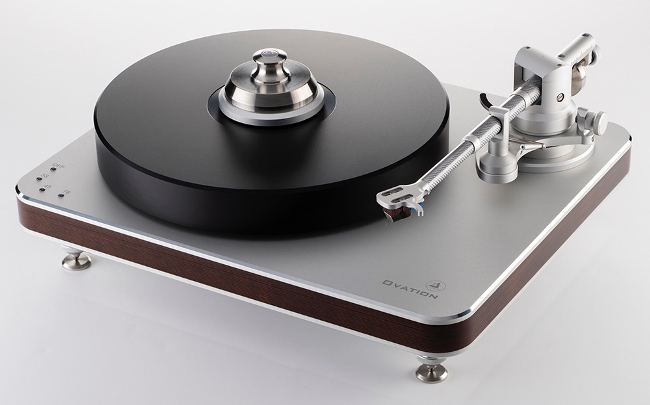
The wood sticks on Bruce Springsteen’s “Two Faces”, from the Tunnel of Love LP, sound very true to life with excellent dynamic impact and a rich wood tone. There is no mistaking the sound of wood sticks hitting each other, even for the fraction of a second that these musical events occur. All sounds have a very natural and complete feel, often lasting well past the initial impulse.
Harmonics, which are the key to a natural sound and believability, seem perfectly reproduced helped by the presence of the external power supply. The included wall-wart power supply is obviously bettered by the optional Smart Power power supply, which seems to increase stage depth and provide darker silences between notes, to name just two of the benefits from this rather expensive optional add-on. A good demonstration of this effect can be heard when playing “Tougher Than the Rest” on the same Springsteen album.
Another listen was to Jethro Tull’s Minstrel in the Gallery LP. When Ian Anderson sings “Isn’t it just too damn real…one duck on your wall”, his virtual presence in the room was eerily apparent. This whole album is a treasure representing some of Anderson’s best work, with terrific melodies, thrilling hooks, and interesting lyrics. If you like that sort of thing.
Microdynamics are extremely articulate and complete. A drumstick tapping on a snare drum or cymbal is usually strikingly correct and specific. Larger scale dynamics are also well rendered. It is easy for the listener to follow individual performers and keep separate sounds distinct. There is no smear or softening around the edges of a sound, and natural detail is well developed.
The more time I spent listening with the Universal tonearm installed the more I appreciated its contribution to the overall sound. The Universal arm is very articulate sounding. The cymbals in Steely Dan’s “I Got the News” are crystal – or metal – clear. The highly resolved sound has no trace of an undifferentiated white noise-type of sound. This distortion is ubiquitous when purity is lacking. The sound of ringing metal or of a piano is unmistakable. The arm’s midrange richness and bass dynamic power are two of its strengths. Long-term, I preferred the smoother upper frequencies of the Agile arm, especially with the electron microscope-like resolution of the ZYX Optimum cartridge.
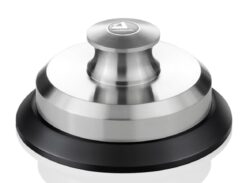 The Outer Limits edge clamp and the Innovation center clamp offered worthwhile improvements. The increase in weight and inertia provided by the Outer Limit enhances harmonic purity and bass power, and it greatly cleans up the soundstage with a much more continuous left-to-right image. Bass notes are better defined and tighter. The Innovation clamp is not such a simple recommendation as a Stillpoints LPI v1 or an Origin Live Gravity center clamp found use with both the Tzar or ZYX cartridges. The Miyajima Destiny cartridge and the Clearaudio Innovation clamp made beautiful music together. The Miyajima was also a better fit sonically with the Universal tonearm.
The Outer Limits edge clamp and the Innovation center clamp offered worthwhile improvements. The increase in weight and inertia provided by the Outer Limit enhances harmonic purity and bass power, and it greatly cleans up the soundstage with a much more continuous left-to-right image. Bass notes are better defined and tighter. The Innovation clamp is not such a simple recommendation as a Stillpoints LPI v1 or an Origin Live Gravity center clamp found use with both the Tzar or ZYX cartridges. The Miyajima Destiny cartridge and the Clearaudio Innovation clamp made beautiful music together. The Miyajima was also a better fit sonically with the Universal tonearm.
Late in the audition an Acoustic Signature Montana Neo arrived. With all the accessories, the entire Ovation kit costs less than half of the cost of the Montana Neo without a tonearm. The sound of the Montana Neo is bigger and bolder, more dynamic, and with a larger, better-defined sound stage. Incrementally better, for sure. But what surprised me more than any specific improvement is that none of these upgrades in the sonic presentation reflected poorly on the excellent performance of the Ovation turntable. If the Montana Neo gets an “A+” rating, the Ovation is not far behind with a solid “A” rating. The Ovation simply blew the tonearm off a Technics SL-1200G, when the direct drive table sounded significantly inferior.
The Clearaudio Ovation, with options, is an excellent music maker, simple to operate, easy to set up, and reliable in long term use. I am happy having the Montana Neo, specifically for its ability to support two tonearms. But knowing what I know now about the apparent but small improvements attainable with more than double the cost, it is without reservation that the Clearaudio Ovation is recommended as a very high performance and enjoyable turntable.
Overall Rating: 9.5 LPs
Link to US distributor: Musical Surroundings
Link to manufacturer: Clearaudio

